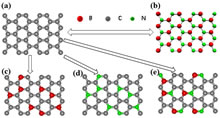Research
Our research focuses on creating new hybridized nanocarbon materials and fabricating various devices for applications in the field of green energy and the environment, nanocomposites, and new generation electronics/sensors.
Synthesis of hybridized nanoCarbon materials

Due to their similar atomic parameters, B, C and N can be substituted for each other and form various semiconducting hexagonal layered structures. As the Figure shows, starting with graphene, B substitution can form p-type graphene, and N doping forms n-type graphene. It is also possible to form C-B and C-N binary chemical compounds with certain stoichiometry, such as BC3, B2C, and CN3, etc. All these stoichiometries have specific electronic structures and properties. Complete B and N co-substitution of C can form a BN hexagonal net, and their partial co-substitution will form a semiconducting BCN hybrid structure.
In this research, we seek to study new hybrid nanocarbon materials, their synthesis, properties and potential applications.
Micro/Nano-device fabrication and analysis for electronics, sensors and active systems
Materials such as CNT and graphene have big advantages over conventional silicon based devices and copper based interconnects.
In this research, we will use nanocarbons for developing a new generation of integrated electronic components. In addtion, we will pursue various approaches to build sensor network systems using nanostructures and their assemblies.
Nanocarbon-based green innovation devices
Thanks to their high carrier mobility with tunable electrical and optical properties, carbon nanotube and graphene have a high potential for creating next generation photovoltaic devices.
In our proposed research, we will work towards the realization of the fabrication of carbon nanotube-based and graphene-based photovoltaic and energy-storage devices, and the exploration of their electronic optical properties and phtotcurrent behavior. Two main devices, including carbon nanotube-silicon heterojunction solar cells and hybrid graphene p-n junction photovoltaic devices, will be fabricated here through our unique synthesis method and lithography technique. Following this, we will determine the electrical and optoelectronic characteristics of these devices using our cryostat probe station measurement system. In particular, the photovoltaic properties will be investigated in a solar simulation system for improving and optimizing the efficiency of these nanocarbon-based photovoltaic devices.
We expect that the advantages of this CNT-based and graphene-based solar cell and supercapacitor will be low cost, high efficiency and the possibility of building the cell on flexible substrates. We believe that our exploration of these nanocarbon based photovoltaic devices will lead to a new direction in solar cell applications.




 ajayan
ajayan
